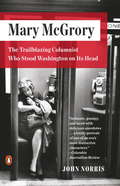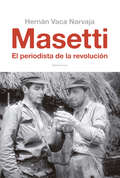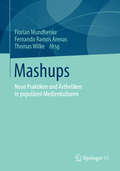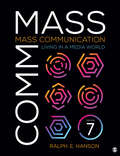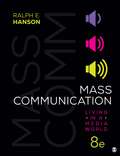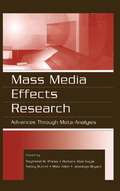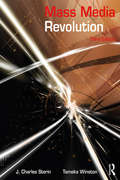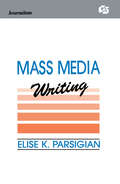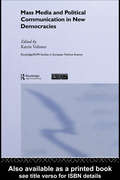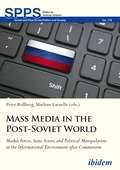- Table View
- List View
Mary McGrory
by John NorrisA wildly entertaining biography of the trailblazing Washington columnist and the first woman to win the Pulitzer Prize for commentary Before there was Maureen Dowd or Gail Collins or Molly Ivins, there was Mary McGrory. She was a trailblazing columnist who achieved national syndication and reported from the front lines of American politics for five decades. From her first assignment reporting on the Army-McCarthy hearings to her Pulitzer-winning coverage of Watergate and controversial observations of President Bush after September 11, McGrory humanized the players on the great national stage while establishing herself as a uniquely influential voice. Behind the scenes she flirted, drank, cajoled, and jousted with the most important figures in American life, breaking all the rules in the journalism textbook. Her writing was admired and feared by such notables as Lyndon Johnson (who also tried to seduce her) and her friend Bobby Kennedy who observed, "Mary is so gentle--until she gets behind a typewriter." Her soirees, filled with Supreme Court justices, senators, interns, and copy boys alike, were legendary. As the red-hot center of the Beltway in a time when the newsrooms were dominated by men, McGrory makes for a powerfully engrossing subject. Laced with juicy gossip and McGrory's own acerbic wit, John Norris's colorful biography reads like an insider's view of latter-day American history--and one of its most enduring characters.
Masculinity and the Trials of Modern Fiction
by Marco WanHow do lawyers, judges and jurors read novels? And what is at stake when literature and law confront each other in the courtroom? Nineteenth-century England and France are remembered for their active legal prosecution of literature, and this book examines the ways in which five novels were interpreted in the courtroom: Gustave Flaubert’s Madame Bovary, Paul Bonnetain’s Charlot s’amuse, Henry Vizetelly’s English translation of Émile Zola’s La Terre, Oscar Wilde’s The Picture of Dorian Gray and Radclyffe Hall’s The Well of Loneliness. It argues that each of these novels attracted legal censure because they presented figures of sexual dissidence – the androgyne, the onanist or masturbator, the patricide, the homosexual and the lesbian – that called into question an increasingly fragile normative, middleclass masculinity. Offering close readings of the novels themselves, and of legal material from the proceedings, such as the trial transcripts and judicial opinions, the book addresses both the doctrinal dimensions of Victorian obscenity and censorship, as well as the reading practices at work in the courtroom. It situates the cases in their historical context, and highlights how each trial constitutes a scene of reading – an encounter between literature and the law – through which different forms of masculinity were shaped, bolstered or challenged.
Masetti: El periodista de la revolución
by Hernan Vaca NarvajaLa biografía de Jorge Ricardo Masetti, personaje fundante del periodismo latinoamericano, quien dedicó su vida a la causa revolucionaria y a la creación de un nuevo rol de la prensa en el continente. Masetti, además, fue el primer periodista argentino que entrevistó al Che Guevara en Sierra Maestra antes del triunfo de la Revolución cubana. En la famosa foto del Che, aquella de Korda que dio vuelta al mundo, había alguien más a quien la magia del revelado dejó a un costado: el argentino Jorge Ricardo Masetti. Fundador de Prensa Latina -la agencia de noticias cubana que llegó a pelearles el lugar a gigantes como la Associated Press y la United Press-, fue uno de los primeros en entrevistar a Fidel Castro y a Guevara cuando todavía combatían en Sierra Maestra. La aventura del periodismo fue un destino al que Masetti se entregó sin vacilaciones, con el mismo fervor con el que se incorporó a la causa revolucionaria, comandando el primer intento de guerrilla rural en la Argentina. Pero se ha perdido su rastro, y sus restos nunca fueron hallados en el monte salteño donde se instaló con sus camaradas de lucha. Tras entrevistar a muchos de los participantes de los hechos, consultar material inédito hasta ahora y revisar periódicos y publicaciones, Hernán Vaca Narvaja ha escrito un libro de aquellos que no se pueden dejar de leer. En su trabajo, la figura de Masetti se convierte en síntesis y símbolo de una época tan convulsionada como fascinante.
Mashups
by Florian Mundhenke Fernando Ramos Arenas Thomas WilkeMashup hat sich als Begriff eingebürgert für auditiv, visuell, audiovisuell ,,vermischte" Neuarrangements, Collagen, Bricolagen in der Musik, in Videos, in Computerspielen, in der (aktuellen Medien-)Kunst, in der Architektur. Es handelt sich um eine Verbindung heterogener Elemente, die etwas (scheinbar) Neues hervorbringen. Im Internet verbinden Websites unterschiedliche Elemente (beispielsweise Musik, Video, Hyperlinks) mit unterschiedlichen Funktionen. Ausgangspunkt für diesen Band ist die These, dass es einerseits mediale und kulturelle Techniken gibt, die diese Form des Mischgenres erst ermöglichen. Andererseits muss berücksichtigt werden, dass die mediale Kompetenz der User exponentiell angestiegen ist und weiter ansteigt. Der Band geht unter anderem der Frage nach, inwieweit es sich bei Mashups um eine qualitativ neue Form der Aneignung und/oder nur eine produktive Auseinandersetzung mit medialen Angeboten handelt.
Mass Communication In India: A Sociological Perspective
by J V VilanilamThis book traces the progress of mass communications in India and the West from a historical and sociological perspective, from primitive to modern times. Placing his argument in the global context within which mass communication takes place, the author: - Emphasizes the distinction between communication and mass communication—the former being a two-way exchange and the latter mostly a one-way communication. - Discusses the relevance of mass communication for the largely illiterate population of India, with particular reference to the type of media content and the inadequacy of conventional schooling. - Discusses the rapid technological progress in the world in recent decades in the context of digitalization, computerization and media convergence, as well as the global nature of mass communication. - Highlights that almost half the world`s population remains untouched by the communications revolution even at the beginning of the 21st century. - Examines the potential of EDUSAT, the educational satellite launched recently, as a means to bring education and information to all sectors of the Indian population.
Mass Communication Theories: Explaining Origins, Processes, and Effects
by Margaret H. DeFleur Melvin L. DeFleurMass Communication Theories: Explaining Origins, Processes, and Effects explores mass communication theories within the social and cultural context that influenced their origins. An intimate examination of the lives and times of prominent mass communication theorists both past and present bring the subject to life for the reader.
Mass Communication: Living in a Media World
by Ralph E. HansonTransform your students into smart, savvy consumers of the media. Mass Communication: Living in a Media World (Ralph E. Hanson) provides students with comprehensive yet concise coverage of all aspects of mass media, along with insightful analysis, robust pedagogy, and fun, conversational writing. In every chapter of this bestselling text, students will explore the latest developments and current events that are rapidly changing the media landscape. This newly revised Sixth Edition is packed with contemporary examples, engaging infographics, and compelling stories about the ways mass media shape our lives. From start to finish, students will learn the media literacy principles and critical thinking skills they need to become savvy media consumers.
Mass Communication: Living in a Media World
by Ralph E. HansonTransform your students into smart, savvy consumers of the media. Mass Communication: Living in a Media World (Ralph E. Hanson) provides students with comprehensive yet concise coverage of all aspects of mass media, along with insightful analysis, robust pedagogy, and fun, conversational writing. In every chapter of this bestselling text, students will explore the latest developments and current events that are rapidly changing the media landscape. This newly revised Sixth Edition is packed with contemporary examples, engaging infographics, and compelling stories about the ways mass media shape our lives. From start to finish, students will learn the media literacy principles and critical thinking skills they need to become savvy media consumers.
Mass Communication: Living in a Media World
by Ralph E. HansonTransform your students into smart, savvy media consumers. A book that students find fun to read and instructors consider educationally valuable, Mass Communication: Living in a Media World provides the media literacy principles and critical thinking skills that students need to become self-aware media consumers. Known for his storytelling approach, bestselling author Ralph E. Hanson uses examples drawn from everyday life to explain the many dimensions of mass media that operate in our society. This newly revised Seventh Edition is packed with contemporary examples and compelling stories that illustrate the latest developments and recent events that are changing the face of media today.
Mass Communication: Living in a Media World
by Ralph E. HansonTransform your students into smart, savvy media consumers. A book that students find fun to read and instructors consider educationally valuable, Mass Communication: Living in a Media World provides the media literacy principles and critical thinking skills that students need to become self-aware media consumers. Known for his storytelling approach, bestselling author Ralph E. Hanson uses examples drawn from everyday life to explain the many dimensions of mass media that operate in our society. This newly revised Seventh Edition is packed with contemporary examples and compelling stories that illustrate the latest developments and recent events that are changing the face of media today.
Mass Communication: Living in a Media World
by Ralph E. HansonThe best-selling Mass Communication: Living in a Media World presents a highly accessible introduction to mass communication that equips students with the critical thinking skills to become savvy media consumers. To help students better retain the material, author Ralph E. Hanson uses a storytelling approach that weaves in examples drawn from everyday life. Readers are encouraged to consider the media industry from the inside out and, in doing so, discover the many dimensions of mass communication that operate in our society. The thoroughly revised Eighth Edition highlights how social and digital media, video games, and the COVID-19 pandemic are changing the face of media. This title is accompanied by a complete teaching and learning package.
Mass Communication: Living in a Media World
by Ralph E. HansonThe best-selling Mass Communication: Living in a Media World presents a highly accessible introduction to mass communication that equips students with the critical thinking skills to become savvy media consumers. To help students better retain the material, author Ralph E. Hanson uses a storytelling approach that weaves in examples drawn from everyday life. Readers are encouraged to consider the media industry from the inside out and, in doing so, discover the many dimensions of mass communication that operate in our society. The thoroughly revised Eighth Edition highlights how social and digital media, video games, and the COVID-19 pandemic are changing the face of media. This title is accompanied by a complete teaching and learning package.
Mass Communication: Living in a Media World
by Ralph E. HansonThe best-selling Mass Communication: Living in a Media World offers an accessible introduction to mass communication, equipping students with the critical thinking skills to become savvy media consumers. Using a storytelling approach, the text weaves in examples drawn from everyday life, making it easier for students to retain the material and connect it to their own media experiences. Readers are encouraged to consider the media industry from the inside out and, in doing so, discover the many dimensions of mass communication that operate in our society. This newly revised Ninth Edition highlights the aftermath of how the media industry and media consumers have evolved since the global pandemic, closely examining the changing the face of media today.
Mass Communication: Living in a Media World
by Ralph E. HansonThe best-selling Mass Communication: Living in a Media World offers an accessible introduction to mass communication, equipping students with the critical thinking skills to become savvy media consumers. Using a storytelling approach, the text weaves in examples drawn from everyday life, making it easier for students to retain the material and connect it to their own media experiences. Readers are encouraged to consider the media industry from the inside out and, in doing so, discover the many dimensions of mass communication that operate in our society. This newly revised Ninth Edition highlights the aftermath of how the media industry and media consumers have evolved since the global pandemic, closely examining the changing the face of media today.
Mass Communications Research Resources: An Annotated Guide (Routledge Communication Series)
by Christopher H. Sterling Susan M. Hill James K. BrackenThis reference book is designed as a road map for researchers who need to find specific information about American mass communication as expeditiously as possible. Taking a topical approach, it integrates publications and organizations into subject-focused chapters for easy user reference. The editors define mass communication to include print journalism and electronic media and the processes by which they communicate messages to their audiences. Included are newspaper, magazine, radio, television, cable, and newer electronic media industries. Within that definition, this volume offers an indexed inventory of more than 1,400 resources on most aspects of American mass communication history, technology, economics, content, audience research, policy, and regulation. The material featured represents the carefully considered judgment of three experts -- two of them librarians -- plus four contributors from different industry venues. The primary focus is on the domestic American print and electronic media industries. Although there is no claim to a complete census of all materials on print journalism and electronic media -- what is available is now too vast for any single guide -- the most important and useful items are here. The emphasis is on material published since 1980, though useful older resources are included as well. Each chapter is designed to stand alone, providing the most important and useful resources of a primary nature -- organizations and documents as well as secondary books and reports. In addition, online resources and internet citations are included where possible.
Mass Disruption
by John StackhouseDrawing on his thirty years in newspapers, the former editor-in-chief of The Globe and Mail examines the crisis of serious journalism in the digital era, and searches for ways the invaluable tradition can thrive in a radically changed future. John Stackhouse entered the newspaper business in a golden age: 1980s circulations were huge and wealthy companies lined up for the privilege of advertising in every city's best-read pages. Television and radio could never rival newspapers for hard news, analysis and opinion, and the papers' brand of serious journalism was considered a crucial part of life in a democratic country. Then came the Internet... After decades as a Globe journalist, foreign bureau chief and then editor of its Report on Business (not to mention former Scarborough delivery boy), he assumed one of the biggest jobs in Canadian journalism: The Globe and Mail's editor-in-chief. Beginning in 2009, he faced the unthinkable: the possible end of not just Canada's "national" newspaper, but the steep and steady financial decline of newspapers everywhere. A non-stop torrent of free digital content stole advertisers and devalued advertising space so quickly that newspapers struggled to finance the serious journalism that distinguished them in a world of Buzzfeed, Huffington Post, Yahoo and innumerable bloggers and citizen journalists. Meanwhile, ambitious online media aspired to the credibility of newspapers. The solution was clear, if the path to arriving at it was less so: the new school needed to meet the old school, and the future lay in undiscovered ground between them. Having led the Globe during this period of sudden and radical change, Stackhouse continues to champion the vital role of great reporting and analysis. Filled with stories from his three decades in the business, Mass Disruption tracks decisions good and bad, examines how some of the world's major newspapers--the Guardian, New York Times--are learning to cope, and lays out strategies for the future, of both newspapers and serious journalism, wherever it may live.From the Hardcover edition.
Mass Media Education in Transition: Preparing for the 21st Century (Routledge Communication Series)
by Thomas DicksonMedia educators have long been debating the nature and purpose of media education. Issues relating to new technologies and the changing state of the media industry are ongoing concerns, but some of the most difficult questions go to the actual structure of media education itself: Is it best represented as an integrated field? Should it merge with other communication subfields, or potentially split into several separate fields? Media practitioners complicate matters further by questioning the necessity for media education at all. The continued consideration of and reaction to these issues will have a significant effect on media-related education and its associated practices. In Mass Media Education in Transition, Thomas Dickson gives careful consideration to the state of media education and its future directions. He provides a history of mass media-related education as well as an overview of the major issues affecting media education at the end of the 20th century. He incorporates the visions of media education leaders as to the possible directions the field may take in the next century and includes in his discussion information that has been previously unknown or not readily available to media educators. This volume provides a broad view of the major issues affecting all aspects of media education: print and broadcast journalism, advertising, public relations, and media studies. It also offers detailed insights as to the possibilities that lie ahead as the field continues to develop--a new professionalism, or a return to a prior vision of media-related education, or possibly something quite different.
Mass Media Effects Research: Advances Through Meta-Analysis (Routledge Communication Ser.)
by Raymond W. Preiss Barbara Mae Gayle Nancy Burrell Mike Allen Jennings BryantThis distinctive collection offers a unique set of meta-analyses covering the breadth of media effects research. Editor Raymond W. Preiss and his colleagues bring together an all-star list of contributors. Organized by theories, outcomes, and mass media campaigns, the chapters included here offer important insights on what current social science re
Mass Media Revolution
by J. Charles Sterin Tameka WinstonNow in its Third Edition, Mass Media Revolution remains a dynamic guide to the world of mass media, enhancing its readers’ development as critical consumers. The text employs a storytelling narrative style and integrated, chapter-specific digital material, providing a seamless learning experience. It features a wealth of expanded content—with particular attention to diversity in the media industry, reality TV, ethics and social media, and the evolution of online journalism. Chapter content, both print and online, is aligned to the ACEJMC national academic standards. Along with student video resources, this text includes an accompanying instructor resource manual and Power Point slides. All supplementary materials can be found at massmediarev.com.
Mass Media Writing (Routledge Communication Series)
by Elise K. ParsigianThis innovative book is the first to identify and describe the systematic process that drives the day-to-day work of writers in the real world of print and broadcast journalism, public relations and advertising. The key to creative problem solution for both simple and complex assignments in media work is engagingly detailed in this thought-provoking guide. Users of this book will learn how to fulfill assignments and write copy that meets an editor's or client's expectations, speaks to the intended audience, stands up to question, and remains in memory. The author skillfully blends tested processes from science and art to equip the student with the tools of self-management and the techniques of disciplined creativity that defend against erroneous judgment. Recognizing the role of problem solving in media and the primacy of critical thinking at all stages of the writing process -- from preparatory measures to final writing -- the author challenges the assumption that discipline and creativity are incompatible partners. That partnership is described in detail, then dramatized with absorbing examples and illustrations drawn from interviews with experienced practitioners in print and broadcast journalism, public relations and advertising. Each chapter is a discovery of how this reliable partnership for solving writing problems in media applies to both anticipated and unexpected communication situations. Making known what media professionals have learned through trial and error on the job, here is a thinking and writing dynamic that students, new hires, and aspiring free-lancers can now acquire before entering the world of print or broadcast journalism, public relations or advertising.
Mass Media and Health: Examining Media Impact on Individuals and the Health Environment
by Kim Walsh-ChildersMass Media and Health: Examining Media Impact on Individuals and the Health Environment covers media health influences from a variety of angles, including the impact on individual and public health, the intentionality of these effects, and the nature of the outcomes. Author Kim Walsh-Childers helps readers understand the influence that mass media has on an individual’s health beliefs and, in turn, their behaviors. She explains how public health policy can be affected, altering the environment in which a community’s members make choices, and discusses the unintentional health effects of mass media, examining them through the strategic lens of news framing and advocacy campaigns. Written for students across a variety of disciplines, Mass Media and Health will serve as primary reading for courses examining the broader view of mass media and health impacts, as well as providing supplemental reading for courses on health communication, public health campaigns, health journalism, and media effects.
Mass Media and Political Communication in New Democracies (Routledge/ECPR Studies in European Political Science #Vol. 42)
by Katrin VoltmerThis book examines how political communication and the mass media have played a central role in the consolidation of emerging democracies around the world. Covering a broad range of political and cultural contexts, including Eastern and Southern Europe, Latin America, Asia and Africa, this new volume investigates the problems and conflicts arising in the process of establishing an independent media and competitive politics in post-autocratic societies. Considering the changing dynamic in the relationship between political actors, the media and their audience, the authors of this volume address the following issues: changing journalistic role perceptions and journalistic quality the reasons and consequences of persisting instrumentalization of the media by political actors the role of the media in election campaigns the way in which the citizens interpret political messages and the extent to which the media influence political attitudes and electoral behaviour the role of the Internet in building a democratic public sphere This book will be of great interest to all those studying and researching democracy and democratization, comparative politics, political communication, journalism, media and the Internet.
Mass Media in the Post-Soviet World: Market Forces, State Actors, and Political Manipulation in the Informational Environment after Communism (Soviet and Post-Soviet Politics and Society #178)
by Marlene Laruelle Peter RollbergThis collection covers the major trends of the media environment of the post-Communist world and their recent development, with special focus on Russia and the post-Soviet space. The term "media environment" covers not just traditional print and electronic media, but new media as well, and ranges from the political to entertainment and various artistic spheres. What role do market forces play in the process of media democratization, and how do state structures regulate, suppress, or use capitalism toward their own gain? What degree of informational pluralism has been achieved in the newly independent republics? What are the prospects for transparency and the participation of civil society in Russian and Eurasian media? To what degree do trends in post-Communist media reflect global trends? Is there a worldwide convergence with regard to both media formats and political messaging?Western observers usually pay their keenest attention to the role of media in Russia and Eurasia during national elections. While this is a valid focus, the present volume, with contributions by Luca Anceschi, Jonathan Becker, Lee B. Becker, Michael Cecire, Marta Dyczok, Nicola Ying Fry, Navbahor Imamova, Azamat Junisbai, Barbara Junisbai, Kornely Kakachia, Maria Lipman, Oleg Manaev, Marintha Miles, Olena Nikolayenko, Sarah Oates, Tamara Pataraia, Elisabeth Schimpfossl, Abdulfattoh Shafiev, Jack Snyder, Tudor Vlad, and Ilya Yablokov, aims at understanding the deeper overall media philosophies that characterize post-Soviet media systems and environments, and the type of identity formation that they are promoting.
Mass Media, An Aging Population, and the Baby Boomers (Routledge Communication Series)
by Jeremy H. Lipschultz Michael L. HiltAs the oldest members of the baby boomer generation head into their retirement years, this demographic shift is having a substantial influence on uses of mass media, as well as the images portrayed in these media. Mass Media, An Aging Population, and the Baby Boomers provides a comprehensive examination of the relationship between media and aging issues, addressing mass media theory and practice as it relates to older Americans.Reviewing current research on communication and gerontology, authors Michael Hilt and Jeremy Lipschultz focus on aging baby boomers and their experiences with television, radio, print media, entertainment, advertising and public relations, along with the Internet and new media. They draw from studies about health and sexuality to understand views of aging, and present a view of older people as important players in the political process. Hilt and Lipschultz conclude the volume by addressing trends and making predictions related to baby boomers and mass media.Providing a timely and insightful examination of the linkage between mass media and aging issues, this volume will prove a valuable resource for scholars and students in media and gerontology. It is intended for use in coursework addressing such topics as mass communication and society, media and aging, media and public opinion, sociology, and social gerontology.
Massive Access for Cellular Internet of Things Theory and Technique (SpringerBriefs in Electrical and Computer Engineering)
by Xiaoming ChenThis book focuses on massive access to the cellular internet of things (IoT). Both theory and technique are addressed, with more weight placed on the latter. This is achieved by providing in-depth studies on a number of central topics such as channel state information acquisition, user clustering, superposition coding, and successive interference cancellation. Four typical application scenarios are examined in detail, namely the stationary IoT device scenario, frequency division duplex-based low-mobility IoT device scenario, time-division duplex-based IoT device scenario, and high-mobility IoT device scenario. The comprehensive and systematic treatment of key techniques in massive access to the cellular IoT is one of the major features of the book, which is particularly suited for readers who are interested in finding practical solutions for the cellular IoT. As such, it will benefit researchers, engineers, and graduate students in the fields of information engineering, telecommunications engineering, computer engineering, etc.
